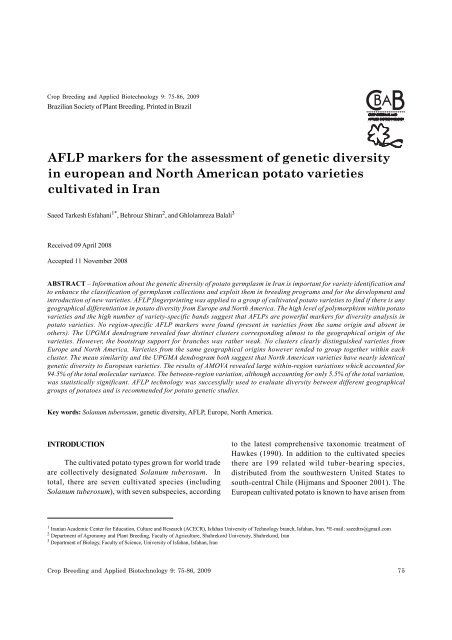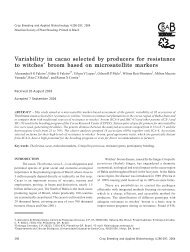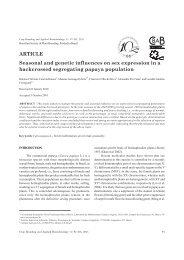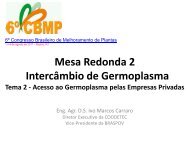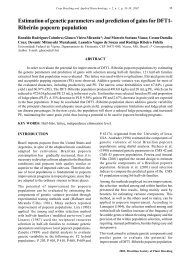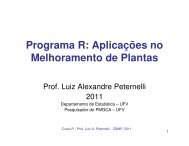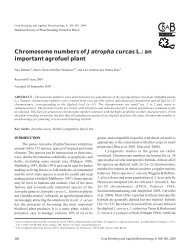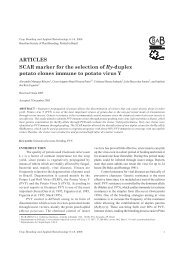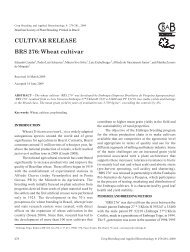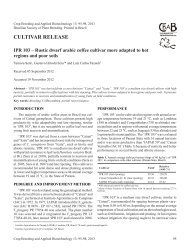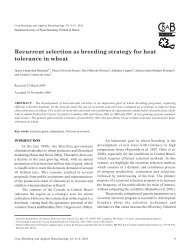AFLP markers for the assessment of genetic diversity in ... - SBMP
AFLP markers for the assessment of genetic diversity in ... - SBMP
AFLP markers for the assessment of genetic diversity in ... - SBMP
You also want an ePaper? Increase the reach of your titles
YUMPU automatically turns print PDFs into web optimized ePapers that Google loves.
<strong>AFLP</strong> <strong>markers</strong> <strong>for</strong> <strong>the</strong> <strong>assessment</strong> <strong>of</strong> <strong>genetic</strong> <strong>diversity</strong> <strong>in</strong> european and North American potato varieties cultivated <strong>in</strong> Iran<br />
Crop Breed<strong>in</strong>g and Applied Biotechnology 9: 75-86, 2009<br />
Brazilian Society <strong>of</strong> Plant Breed<strong>in</strong>g. Pr<strong>in</strong>ted <strong>in</strong> Brazil<br />
<strong>AFLP</strong> <strong>markers</strong> <strong>for</strong> <strong>the</strong> <strong>assessment</strong> <strong>of</strong> <strong>genetic</strong> <strong>diversity</strong><br />
<strong>in</strong> european and North American potato varieties<br />
cultivated <strong>in</strong> Iran<br />
Saeed Tarkesh Esfahani 1* , Behrouz Shiran 2 , and Ghlolamreza Balali 3<br />
Received 09 April 2008<br />
Accepted 11 November 2008<br />
ABSTRACT – In<strong>for</strong>mation about <strong>the</strong> <strong>genetic</strong> <strong>diversity</strong> <strong>of</strong> potato germplasm <strong>in</strong> Iran is important <strong>for</strong> variety identification and<br />
to enhance <strong>the</strong> classification <strong>of</strong> germplasm collections and exploit <strong>the</strong>m <strong>in</strong> breed<strong>in</strong>g programs and <strong>for</strong> <strong>the</strong> development and<br />
<strong>in</strong>troduction <strong>of</strong> new varieties. <strong>AFLP</strong> f<strong>in</strong>gerpr<strong>in</strong>t<strong>in</strong>g was applied to a group <strong>of</strong> cultivated potato varieties to f<strong>in</strong>d if <strong>the</strong>re is any<br />
geographical differentiation <strong>in</strong> potato <strong>diversity</strong> from Europe and North America. The high level <strong>of</strong> polymorphism with<strong>in</strong> potato<br />
varieties and <strong>the</strong> high number <strong>of</strong> variety-specific bands suggest that <strong>AFLP</strong>s are powerful <strong>markers</strong> <strong>for</strong> <strong>diversity</strong> analysis <strong>in</strong><br />
potato varieties. No region-specific <strong>AFLP</strong> <strong>markers</strong> were found (present <strong>in</strong> varieties from <strong>the</strong> same orig<strong>in</strong> and absent <strong>in</strong><br />
o<strong>the</strong>rs). The UPGMA dendrogram revealed four dist<strong>in</strong>ct clusters correspond<strong>in</strong>g almost to <strong>the</strong> geographical orig<strong>in</strong> <strong>of</strong> <strong>the</strong><br />
varieties. However, <strong>the</strong> bootstrap support <strong>for</strong> branches was ra<strong>the</strong>r weak. No clusters clearly dist<strong>in</strong>guished varieties from<br />
Europe and North America. Varieties from <strong>the</strong> same geographical orig<strong>in</strong>s however tended to group toge<strong>the</strong>r with<strong>in</strong> each<br />
cluster. The mean similarity and <strong>the</strong> UPGMA dendrogram both suggest that North American varieties have nearly identical<br />
<strong>genetic</strong> <strong>diversity</strong> to European varieties. The results <strong>of</strong> AMOVA revealed large with<strong>in</strong>-region variations which accounted <strong>for</strong><br />
94.5% <strong>of</strong> <strong>the</strong> total molecular variance. The between-region variation, although account<strong>in</strong>g <strong>for</strong> only 5.5% <strong>of</strong> <strong>the</strong> total variation,<br />
was statistically significant. <strong>AFLP</strong> technology was successfully used to evaluate <strong>diversity</strong> between different geographical<br />
groups <strong>of</strong> potatoes and is recommended <strong>for</strong> potato <strong>genetic</strong> studies.<br />
Key words: Solanum tuberosum, <strong>genetic</strong> <strong>diversity</strong>, <strong>AFLP</strong>, Europe, North America.<br />
INTRODUCTION<br />
The cultivated potato types grown <strong>for</strong> world trade<br />
are collectively designated Solanum tuberosum. In<br />
total, <strong>the</strong>re are seven cultivated species (<strong>in</strong>clud<strong>in</strong>g<br />
Solanum tuberosum), with seven subspecies, accord<strong>in</strong>g<br />
to <strong>the</strong> latest comprehensive taxonomic treatment <strong>of</strong><br />
Hawkes (1990). In addition to <strong>the</strong> cultivated species<br />
<strong>the</strong>re are 199 related wild tuber-bear<strong>in</strong>g species,<br />
distributed from <strong>the</strong> southwestern United States to<br />
south-central Chile (Hijmans and Spooner 2001). The<br />
European cultivated potato is known to have arisen from<br />
1 Iranian Academic Center <strong>for</strong> Education, Culture and Research (ACECR), Isfahan University <strong>of</strong> Technology branch, Isfahan, Iran. *E-mail: saeedtrs@gmail.com<br />
2 Department <strong>of</strong> Agronomy and Plant Breed<strong>in</strong>g, Faculty <strong>of</strong> Agriculture, Shahrekord University, Shahrekord, Iran<br />
3 Department <strong>of</strong> Biology, Faculty <strong>of</strong> Science, University <strong>of</strong> Isfahan, Isfahan, Iran<br />
Crop Breed<strong>in</strong>g and Applied Biotechnology 9: 75-86, 2009 75
ST Esfahani et al.<br />
a limited number <strong>of</strong> <strong>in</strong>troductions (Glend<strong>in</strong>n<strong>in</strong>g 1983),<br />
result<strong>in</strong>g <strong>in</strong> a low level <strong>of</strong> <strong>genetic</strong> <strong>diversity</strong>, compared<br />
to <strong>the</strong> potato gene pool <strong>of</strong> <strong>the</strong> American countries.<br />
Moreover, <strong>the</strong> selection <strong>of</strong> genotypes which produced<br />
tubers under long day-length conditions, comb<strong>in</strong>ed with<br />
selection <strong>for</strong> superior agronomic traits, fur<strong>the</strong>r narrowed<br />
<strong>the</strong> European gene pool (Provan et al. 1999).<br />
By 1975 potato was planted <strong>in</strong> nearly all prov<strong>in</strong>ces<br />
<strong>of</strong> <strong>the</strong> Iran and ranked nationally as <strong>the</strong> third most<br />
important crop, after wheat and rice (Avval 1976,<br />
Shamoradi 1985). Although Iran is clearly one <strong>of</strong> <strong>the</strong><br />
largest potato producers <strong>in</strong> <strong>the</strong> Middle East, reliable<br />
data on recent production and on <strong>the</strong> history <strong>of</strong> <strong>for</strong>mer<br />
and current varieties is rare or non-existent and<br />
production statistics published by different sources vary<br />
largely. Accord<strong>in</strong>g to <strong>the</strong> Iranian M<strong>in</strong>istry <strong>of</strong> Agriculture,<br />
<strong>the</strong> total potato production <strong>in</strong> <strong>the</strong> 2004/2005 and 2005/<br />
2006 grow<strong>in</strong>g seasons was 4,830,124 and 4,218,522 tons<br />
and <strong>the</strong> mean potato yield was 25.76 and 26.20 t/ha,<br />
respectively. Be<strong>for</strong>e 1986 no basic seed potato was<br />
produced <strong>in</strong> Iran and most farmers used to ei<strong>the</strong>r save a<br />
portion <strong>of</strong> <strong>the</strong>ir harvest, buy uncertified seed tubers at<br />
local markets or trade seed potatoes with o<strong>the</strong>r farmers<br />
to provide seed <strong>for</strong> <strong>the</strong> follow<strong>in</strong>g crop season. A program<br />
was established <strong>in</strong> <strong>the</strong> mid-1970’s to multiply and<br />
distribute certified seed imported from Europe.<br />
Thereafter, despite occasional <strong>in</strong>terruptions, almost all<br />
potatoes cultivated commercially and used <strong>in</strong> breed<strong>in</strong>g<br />
and screen<strong>in</strong>g programs <strong>in</strong> Iran, were <strong>in</strong>troduced from<br />
European countries, particularly from <strong>the</strong> Ne<strong>the</strong>rlands<br />
and Germany. In recent years, some national research<br />
centers and producers began to <strong>in</strong>troduce some North<br />
American and compare <strong>the</strong>m with <strong>the</strong> traditional<br />
European varieties, to replace degenerat<strong>in</strong>g European<br />
by novel American varieties. The recently <strong>in</strong>troduced<br />
North American varieties had been selected as<br />
commercially more pr<strong>of</strong>itable <strong>in</strong> <strong>the</strong>ir countries <strong>of</strong> orig<strong>in</strong>.<br />
Actually almost all studied varieties are globally known<br />
as outstand<strong>in</strong>g varieties.<br />
The success <strong>of</strong> any <strong>genetic</strong> conservation and<br />
breed<strong>in</strong>g program depends largely on <strong>the</strong> identification<br />
<strong>of</strong> <strong>the</strong> amount and distribution <strong>of</strong> <strong>genetic</strong> <strong>diversity</strong> <strong>in</strong><br />
<strong>the</strong> gene pool <strong>of</strong> <strong>the</strong> concerned plant. Knowledge on<br />
<strong>the</strong> <strong>genetic</strong> <strong>diversity</strong> and relationships among plant<br />
varieties is important to recognize gene pools, to identify<br />
gaps <strong>in</strong> germplasm collections and to develop effective<br />
conservation and management strategies. In this way,<br />
molecular evaluations can provide <strong>in</strong>sights <strong>in</strong>to <strong>the</strong><br />
<strong>genetic</strong> structure and <strong>diversity</strong> with<strong>in</strong> and among<br />
varieties from different geographical orig<strong>in</strong>s, producers<br />
and distributors. Without this <strong>in</strong><strong>for</strong>mation, breeders<br />
have no means <strong>of</strong> select<strong>in</strong>g appropriate plant material<br />
<strong>for</strong> <strong>the</strong> participation <strong>in</strong> screen<strong>in</strong>g and breed<strong>in</strong>g programs,<br />
with a view to <strong>the</strong> <strong>in</strong>troduction <strong>of</strong> novel varieties <strong>in</strong>to a<br />
country (Russell et al. 1997).<br />
In<strong>for</strong>mation about <strong>the</strong> <strong>genetic</strong> <strong>diversity</strong> <strong>of</strong> potato<br />
germplasm <strong>in</strong> Iran is particularly important <strong>for</strong> variety<br />
identification, to enhance <strong>the</strong> classification <strong>of</strong><br />
germplasm collections and exploit<strong>in</strong>g <strong>the</strong>m <strong>in</strong> breed<strong>in</strong>g<br />
programs and <strong>for</strong> <strong>the</strong> development and <strong>in</strong>troduction <strong>of</strong><br />
new varieties. The uni<strong>for</strong>mity and <strong>genetic</strong> purity <strong>of</strong><br />
potato varieties are also highly important at <strong>the</strong> different<br />
cultivation stages and <strong>for</strong> ma<strong>in</strong>tenance, at harvest and<br />
<strong>for</strong> <strong>the</strong> process<strong>in</strong>g <strong>in</strong>dustries. A lack <strong>of</strong> attention to this<br />
important issue may lead to <strong>the</strong> presence <strong>of</strong> tubers <strong>of</strong><br />
different colors and sizes <strong>in</strong> a collection <strong>of</strong> potato<br />
tubers, <strong>in</strong>dicat<strong>in</strong>g low <strong>genetic</strong> purity and <strong>the</strong> presence<br />
<strong>of</strong> more than one variety <strong>in</strong> a tuber collection.<br />
In this study <strong>the</strong> ma<strong>in</strong> objective was to assess<br />
<strong>the</strong> level <strong>of</strong> <strong>genetic</strong> <strong>diversity</strong> with<strong>in</strong> and among<br />
cultivated potatoes <strong>in</strong>troduced from different orig<strong>in</strong>s<br />
<strong>in</strong> order to specify primary sources <strong>of</strong> germplasm <strong>for</strong><br />
variety improvement programs. Particularly, it was<br />
<strong>in</strong>vestigated if <strong>the</strong>re is any geographical differentiation<br />
<strong>in</strong> potato <strong>diversity</strong> between Europe and North America.<br />
Additionally, <strong>the</strong> <strong>AFLP</strong> ability was evaluated <strong>for</strong> potato<br />
<strong>genetic</strong> studies as well as <strong>for</strong> a discrim<strong>in</strong>ation <strong>of</strong> potato<br />
varieties, based on <strong>the</strong>ir geographical orig<strong>in</strong> and<br />
producers. Apart from <strong>the</strong> regional importance <strong>of</strong> our<br />
studies (<strong>in</strong> Iran), s<strong>in</strong>ce most <strong>of</strong> <strong>the</strong> studied varieties<br />
are commercially important <strong>in</strong> <strong>the</strong>ir countries <strong>of</strong> orig<strong>in</strong><br />
as well as <strong>in</strong> many potato produc<strong>in</strong>g countries, <strong>the</strong><br />
results may serve as relevant source <strong>of</strong> <strong>in</strong><strong>for</strong>mation<br />
about <strong>the</strong> general value <strong>of</strong> cultivated potato<br />
germplasm.<br />
<strong>AFLP</strong> has already been used successfully with a<br />
number <strong>of</strong> crops such as rice (Mackill et al. 1996), tea<br />
(Paul et al. 1997), almond (Sorkheh et al. 2007), barley<br />
(Russel et al. 1997), Cynodon species (Wu et al. 2005),<br />
and has been shown to reveal significant levels <strong>of</strong> DNA<br />
polymorphism <strong>in</strong> plants (Vos et al. 1995). The<br />
advantages <strong>of</strong> this technique <strong>in</strong>clude <strong>the</strong> large number<br />
<strong>of</strong> loci analyzed, high polymorphism levels, high<br />
reproducibility without prior sequence knowledge,<br />
and genome-wide marker distribution (Powell et al.<br />
1996).<br />
76 Crop Breed<strong>in</strong>g and Applied Biotechnology 9: 75-86, 2009
<strong>AFLP</strong> <strong>markers</strong> <strong>for</strong> <strong>the</strong> <strong>assessment</strong> <strong>of</strong> <strong>genetic</strong> <strong>diversity</strong> <strong>in</strong> european and North American potato varieties cultivated <strong>in</strong> Iran<br />
MATERIAL AND METHODS<br />
Plant material and DNA extraction<br />
The 25 accessions <strong>of</strong> Solanum tuberosum<br />
analyzed are presented <strong>in</strong> Table 1. Leaf material from<br />
each <strong>of</strong> 25 plant varieties were harvested from healthy<br />
seedl<strong>in</strong>gs grown <strong>in</strong> a glasshouse. The leaf tissue was<br />
immediately immersed <strong>in</strong> liquid N and stored until use.<br />
Total genomic DNA was extracted us<strong>in</strong>g <strong>the</strong> CTAB<br />
method, as described by Murray and Thompson (1980)<br />
and modified by Weis<strong>in</strong>g et al. (1995). The purified total<br />
DNA was quantified by gel electrophoresis and <strong>the</strong><br />
quality verified by spectrophotometry. DNA samples<br />
were stored at 4 °C. Two <strong>in</strong>dependent extractions were<br />
per<strong>for</strong>med <strong>for</strong> each sample.<br />
<strong>AFLP</strong> analysis<br />
Details <strong>of</strong> <strong>AFLP</strong> assay, adapter and primer<br />
sequences, PCR conditions <strong>for</strong> pre-selective and<br />
selective amplifications, and PCR product<br />
electrophoresis were per<strong>for</strong>med accord<strong>in</strong>g to Vos et al.<br />
(1995) and Sorkheh et al. (2007). Genomic DNA was<br />
restricted with PstI/Tru1I enzyme comb<strong>in</strong>ation, doublestranded<br />
adapters specific to each site were ligated, and<br />
pre-selective amplification was per<strong>for</strong>med with primers<br />
complementary to <strong>the</strong> adaptors and with one selective<br />
base at <strong>the</strong> 3‘ end. Selective amplification was carried<br />
out with 15 primer comb<strong>in</strong>ations which were syn<strong>the</strong>sized<br />
by MWG (Germany) (Table 2). Fragments were resolved<br />
us<strong>in</strong>g acrylamide sequenc<strong>in</strong>g gels (Gibco-BRL, Biometra,<br />
Germany) conta<strong>in</strong><strong>in</strong>g 7 M urea <strong>in</strong> 1 × TBE buffer. Gels<br />
were run <strong>for</strong> 1.5–2 h at 100 W until <strong>the</strong> <strong>for</strong>ward runn<strong>in</strong>g<br />
dye (Bromophenol blue) reached <strong>the</strong> end <strong>of</strong> <strong>the</strong> gel. The<br />
DNA bands were visualized by silver sta<strong>in</strong><strong>in</strong>g, as<br />
described by Bassam and Caetano-Anolles (1993).<br />
Scor<strong>in</strong>g and data analysis<br />
For <strong>the</strong> <strong>genetic</strong> relationship studies, only dist<strong>in</strong>ct,<br />
reproducible, well-resolved <strong>AFLP</strong> fragments <strong>in</strong> <strong>the</strong> size<br />
range <strong>of</strong> 67-501 bp were scored as present (1) or absent<br />
(0), and a b<strong>in</strong>ary data matrix was constructed based on<br />
band scores. Different polymorphic fragments produced<br />
Table 1. Name, country <strong>of</strong> orig<strong>in</strong>, and geographical orig<strong>in</strong> <strong>of</strong> 25 potato varieties studied <strong>in</strong> <strong>AFLP</strong> analysis<br />
Crop Breed<strong>in</strong>g and Applied Biotechnology 9: 75-86, 2009 77
ST Esfahani et al.<br />
Table 2. Oligonucleotide adapter and primer names and sequences <strong>for</strong> 16 selective amplified fragment length polymorphism primer<br />
comb<strong>in</strong>ations (assay units)<br />
by each primer were treated as unit and numbered<br />
sequentially. Monomorphic fragments and those with<br />
low <strong>in</strong>tensity were not taken <strong>in</strong>to account. Similarity<br />
<strong>in</strong>dices were calculated us<strong>in</strong>g <strong>the</strong> coefficients <strong>of</strong> Jaccard<br />
and Simple Match<strong>in</strong>g (SM) to estimate relationships<br />
between cultivars. A dendrogram <strong>of</strong> <strong>genetic</strong> relationship<br />
was produced by cluster<strong>in</strong>g <strong>the</strong> data us<strong>in</strong>g <strong>the</strong><br />
unweighted pair group method with arithmetic average<br />
(UPGMA). The cophenetic correlation coefficient was<br />
calculated, and <strong>the</strong> Mantel test (Mantel 1967) was<br />
per<strong>for</strong>med to check <strong>the</strong> goodness <strong>of</strong> fit <strong>of</strong> cluster<br />
analysis to <strong>the</strong> similarity matrix on which it was used.<br />
By <strong>the</strong> Mantel test, <strong>the</strong> correlation between <strong>the</strong><br />
similarity matrix and <strong>the</strong> cophenetic matrix obta<strong>in</strong>ed by<br />
<strong>the</strong> Jaccard and SM coefficients, respectively, is<br />
calculated separately. Then <strong>the</strong> method by which <strong>the</strong><br />
correlation coefficient is higher is selected <strong>for</strong> analysis.<br />
All above steps were per<strong>for</strong>med us<strong>in</strong>g <strong>the</strong> NTSYS-pc<br />
2.02 s<strong>of</strong>tware package (Rohlf 1998). The relative support<br />
<strong>for</strong> <strong>the</strong> different groups and stability <strong>of</strong> <strong>the</strong> dendrogram,<br />
was assessed by bootstrap analysis (5,000 replicates),<br />
us<strong>in</strong>g <strong>the</strong> TREECON s<strong>of</strong>tware package version 1.3 (Van<br />
de Peer and De Wachter 1994). The <strong>in</strong><strong>for</strong>mation content<br />
<strong>of</strong> each <strong>AFLP</strong> marker was computed as PIC i = 1-Σpi 2 ,<br />
where pi is <strong>the</strong> frequency <strong>of</strong> <strong>the</strong> i th band. The Mean<br />
polymorphic <strong>in</strong><strong>for</strong>mation content (PIC) was calculated<br />
<strong>for</strong> <strong>AFLP</strong> <strong>markers</strong> across assay units by apply<strong>in</strong>g <strong>the</strong><br />
above <strong>for</strong>mula, proposed by Powell et al. (1996). The<br />
discrim<strong>in</strong>ation power <strong>of</strong> each <strong>AFLP</strong> marker was<br />
evaluated by <strong>the</strong> polymorphism <strong>in</strong><strong>for</strong>mation content<br />
(PIC). F<strong>in</strong>ally, <strong>the</strong> partition<strong>in</strong>g <strong>of</strong> molecular variance<br />
with<strong>in</strong> and among groups and accessions was<br />
calculated by <strong>the</strong> AMOVA technique (Exc<strong>of</strong>fier et al.<br />
1992) us<strong>in</strong>g ARLEQUIN s<strong>of</strong>tware (Schneider et al. 2001).<br />
All significance tests were per<strong>for</strong>med with 1023<br />
permutations.<br />
RESULTS AND DISCUSSION<br />
Levels <strong>of</strong> <strong>AFLP</strong> polymorphism<br />
In this study we applied <strong>AFLP</strong> f<strong>in</strong>gerpr<strong>in</strong>t<strong>in</strong>g to<br />
evaluate <strong>diversity</strong> <strong>in</strong> potato. The 16 primer<br />
comb<strong>in</strong>ations generated 564 polymorphic and clearly<br />
78 Crop Breed<strong>in</strong>g and Applied Biotechnology 9: 75-86, 2009
<strong>AFLP</strong> <strong>markers</strong> <strong>for</strong> <strong>the</strong> <strong>assessment</strong> <strong>of</strong> <strong>genetic</strong> <strong>diversity</strong> <strong>in</strong> european and North American potato varieties cultivated <strong>in</strong> Iran<br />
scorable fragments across <strong>the</strong> 25 varieties (Figure 1).<br />
The number <strong>of</strong> polymorphic fragments ranged from 16<br />
<strong>for</strong> <strong>the</strong> primer comb<strong>in</strong>ation T-GAG/P-ACC to 52 <strong>for</strong> T-<br />
CAC/P-GCC, T-GCA/P-AGC and T-GCT/P-ACT, with a<br />
mean <strong>of</strong> 35.25 fragments per primer comb<strong>in</strong>ation.<br />
PIC values ranged between 0.48 and 0.723, with a<br />
mean <strong>of</strong> 0.606. PIC provides an estimate <strong>of</strong> <strong>the</strong><br />
discrim<strong>in</strong>atory power <strong>of</strong> a marker by tak<strong>in</strong>g <strong>in</strong>to account<br />
not only <strong>the</strong> number <strong>of</strong> alleles, but also <strong>the</strong>ire relative<br />
frequencies. The distribution <strong>of</strong> PIC scores was nearly<br />
uni<strong>for</strong>m (random) <strong>for</strong> all 564 polymorphic <strong>AFLP</strong> <strong>markers</strong>.<br />
Results show that most <strong>of</strong> <strong>the</strong> <strong>markers</strong> have a high<br />
discrim<strong>in</strong>ation power.<br />
The high number <strong>of</strong> polymorphic bands and <strong>the</strong><br />
high level <strong>of</strong> polymorphism with<strong>in</strong> potato varieties<br />
suggest that <strong>AFLP</strong>s are highly discrim<strong>in</strong>atory and<br />
powerful <strong>markers</strong> <strong>for</strong> classification, f<strong>in</strong>gerpr<strong>in</strong>t<strong>in</strong>g and<br />
<strong>diversity</strong> analysis <strong>in</strong> cultivated potato varieties and<br />
most likely <strong>in</strong> wild relatives and populations as well.<br />
Fur<strong>the</strong>rmore, <strong>the</strong> high polymorphism produced make<br />
<strong>AFLP</strong> <strong>markers</strong> a powerful tool <strong>for</strong> genotyp<strong>in</strong>g a large<br />
number <strong>of</strong> accessions and suitable <strong>for</strong> <strong>the</strong> evaluation<br />
<strong>of</strong> <strong>genetic</strong> <strong>diversity</strong> <strong>in</strong> large potato gene banks.<br />
There were no region-specific (diagnostic) <strong>markers</strong><br />
(present <strong>in</strong> varieties from <strong>the</strong> same geographical orig<strong>in</strong><br />
and absent <strong>in</strong> o<strong>the</strong>rs) and no <strong>AFLP</strong> marker could clearly<br />
discrim<strong>in</strong>ate European from North American potato<br />
varieties. The variation range <strong>of</strong> <strong>genetic</strong> similarity (GS)<br />
coefficients <strong>in</strong> two groups differed only slightly, where<br />
<strong>the</strong> values varied from 0.697 to 0.881 (irrespective <strong>of</strong><br />
GS=0.923 between Ayg-2 and Yukon Gold) <strong>in</strong> North<br />
American and from 0.701 to 0.845 <strong>in</strong> European varieties.<br />
This may <strong>in</strong>dicate potentially identical <strong>diversity</strong> <strong>in</strong><br />
European and North American potato gene pools.<br />
Cluster and bootstrap analysis<br />
Cluster analysis us<strong>in</strong>g Jaccard and simple match<strong>in</strong>g<br />
coefficients led to near agglomerations. By <strong>the</strong> SM<br />
coefficient <strong>the</strong> absence <strong>of</strong> bands (score 00) was recorded<br />
as well. However, such cases do not necessarily imply<br />
an identity between two genomes (Bornet et al. 2001).<br />
The Jaccard coefficient on <strong>the</strong> o<strong>the</strong>r hand only considers<br />
matches between bands that are present (11) and ignores<br />
pairs <strong>in</strong> which a band is absent <strong>in</strong> both <strong>in</strong>dividuals<br />
(Mohammadi and Prassana 2001), so it is recommended<br />
<strong>for</strong> dom<strong>in</strong>ant <strong>markers</strong> such as <strong>AFLP</strong> (L<strong>in</strong>k et al. 1995).<br />
Figure 1. Electrophoretic pattern <strong>of</strong> primer comb<strong>in</strong>ations M-GCA/P-AGC (left) and M-GCA/P-AAC (right). The first and last l<strong>in</strong>es <strong>in</strong><br />
both images represent <strong>the</strong> ladder (VIII marker) pattern and <strong>the</strong> 25 middle l<strong>in</strong>es correspond to varieties <strong>in</strong> Table 1 with <strong>the</strong> same<br />
arrangement (1-25, from left to right)<br />
Crop Breed<strong>in</strong>g and Applied Biotechnology 9: 75-86, 2009 79
ST Esfahani et al.<br />
Data cluster<strong>in</strong>g us<strong>in</strong>g <strong>the</strong> Jaccard matrix showed a<br />
clear separation <strong>of</strong> <strong>the</strong> 25 cultivated potato varieties<br />
(Figure 2). The Mantel test resulted <strong>in</strong> a 0.99 cophenetic<br />
coefficient <strong>for</strong> <strong>the</strong> Jaccard coefficient. The UPGMA<br />
dendrogram revealed clusters that almost corresponded<br />
to <strong>the</strong> geographical orig<strong>in</strong> <strong>of</strong> <strong>the</strong> varieties. However,<br />
ra<strong>the</strong>r weak bootstrap supports were revealed <strong>for</strong><br />
branches separat<strong>in</strong>g varieties from <strong>the</strong> same orig<strong>in</strong>,<br />
particularly those from Europe (Figure 3). The reason<br />
was most likely <strong>the</strong> homogeneous nature <strong>of</strong> European<br />
varieties and <strong>the</strong> <strong>in</strong>tr<strong>in</strong>sic similarities between potato<br />
varieties s<strong>in</strong>ce <strong>the</strong>se orig<strong>in</strong>ally shared a limited gene<br />
pool exploited <strong>in</strong> European countries. No clusters<br />
dist<strong>in</strong>guished varieties from Europe and North America<br />
clearly. With<strong>in</strong> each cluster, varieties from <strong>the</strong> same<br />
geographical orig<strong>in</strong>s however tended to group toge<strong>the</strong>r<br />
and <strong>the</strong> overall geographic proximity was ra<strong>the</strong>r high,<br />
as shown by <strong>the</strong> <strong>AFLP</strong> dendrogram. This agrees with<br />
Bornet et al. (2001), who constructed a dendrogram<br />
which revealed two ma<strong>in</strong> clusters correspond<strong>in</strong>g to<br />
potatoes from Argent<strong>in</strong>a and from Europe (Bornet et al.<br />
2002).<br />
North American varieties tended to group toge<strong>the</strong>r<br />
and this cluster was more clearly dist<strong>in</strong>guished and<br />
more strongly supported than <strong>the</strong> European (Figure 3).<br />
However <strong>the</strong> mean similarity and <strong>the</strong> UPGMA<br />
dendrogram both suggested that <strong>the</strong> <strong>genetic</strong> <strong>diversity</strong><br />
<strong>in</strong> North American is ra<strong>the</strong>r similar to that <strong>in</strong> European<br />
varieties. Although <strong>the</strong> European cultivated potato is<br />
known to have arisen from a limited number <strong>of</strong><br />
<strong>in</strong>troductions (Glend<strong>in</strong>n<strong>in</strong>g 1983) result<strong>in</strong>g <strong>in</strong> a lower<br />
level <strong>of</strong> <strong>genetic</strong> <strong>diversity</strong> compared to <strong>the</strong> American<br />
potato gene pool, <strong>the</strong> slight difference between Europe<br />
and North America <strong>in</strong> <strong>genetic</strong> <strong>diversity</strong> <strong>in</strong>dicates here<br />
that <strong>the</strong> smaller geographical distance <strong>of</strong> North<br />
American countries to <strong>the</strong> ma<strong>in</strong> orig<strong>in</strong> <strong>of</strong> potatoes (South<br />
America) does not necessarily contribute to a higher<br />
<strong>genetic</strong> <strong>diversity</strong> <strong>in</strong> <strong>the</strong> potato gene pool. There<strong>for</strong>e <strong>the</strong><br />
more diverse potato germplasm from South American<br />
countries is still preferable <strong>for</strong> <strong>in</strong>troduction <strong>in</strong>to<br />
breed<strong>in</strong>g programs and fur<strong>the</strong>r improvement <strong>of</strong> potato<br />
varieties <strong>in</strong> a country.<br />
Among <strong>the</strong> studied verities, <strong>the</strong>re are three<br />
(Serrana, Achirana and Aracy) native to South American<br />
countries (Table 1). They were however selected from<br />
European collections and <strong>in</strong>troduced <strong>in</strong> Iran via Europe.<br />
Thereafter <strong>the</strong>y were cultivated <strong>in</strong> <strong>the</strong> country <strong>for</strong> many<br />
years along with those orig<strong>in</strong>ated from Europe. As<br />
Figure 2. UPGMA dendrogram <strong>of</strong> 25 potato (Solanum tuberosum ssp. tuberosum) varieties revealed by <strong>AFLP</strong> data based on Jaccard’s<br />
coefficient<br />
80 Crop Breed<strong>in</strong>g and Applied Biotechnology 9: 75-86, 2009
<strong>AFLP</strong> <strong>markers</strong> <strong>for</strong> <strong>the</strong> <strong>assessment</strong> <strong>of</strong> <strong>genetic</strong> <strong>diversity</strong> <strong>in</strong> european and North American potato varieties cultivated <strong>in</strong> Iran<br />
Figure 3. Bootstrap tree <strong>of</strong> 25 studied potato varieties revealed by <strong>AFLP</strong> data based on Jaccard’s coefficient. Bootstrap support value<br />
is given above each branch<br />
<strong>in</strong>dicated <strong>in</strong> <strong>the</strong> dendrogram, <strong>in</strong> <strong>genetic</strong> analyses <strong>the</strong>se<br />
three varieties tend to group with European ra<strong>the</strong>r than<br />
with North American varieties (Figure 2). These results<br />
may <strong>in</strong>dicate <strong>the</strong> role <strong>of</strong> factors o<strong>the</strong>r than orig<strong>in</strong> <strong>in</strong> <strong>the</strong><br />
determ<strong>in</strong>ation <strong>of</strong> <strong>genetic</strong> similarities, which may<br />
contribute to a fur<strong>the</strong>r separation <strong>of</strong> <strong>genetic</strong>ally<br />
homogeneous potato germplasm. Bornet et al. (1997)<br />
reported that <strong>in</strong> <strong>the</strong>ir studies Argent<strong>in</strong>ean potato<br />
varieties could be fur<strong>the</strong>r subdivided <strong>in</strong>to two groups,<br />
correspond<strong>in</strong>g to some <strong>of</strong> <strong>the</strong> most cultivated varieties<br />
<strong>in</strong> South America and to three different dates <strong>of</strong> creation<br />
(Bornet et al. 1997).<br />
In <strong>the</strong> cluster obta<strong>in</strong>ed here, Yukon Gold and Ayg-<br />
2 were considerably similar and not dist<strong>in</strong>guishable from<br />
each o<strong>the</strong>r (GS= 0.9233). Ayg-2 is a selection from Yukon<br />
Gold germplasm and had been selected due to<br />
morphological differences observed <strong>in</strong> tissue culture<br />
assays at <strong>the</strong> Iranian Potato Research Center, and was<br />
compared with newly <strong>in</strong>troduced germplasm. Results<br />
<strong>in</strong>dicate however that Yukon Gold and its selection were<br />
not <strong>genetic</strong>ally divergent enough to be considered as<br />
two different varieties and <strong>the</strong>ir similarity is firmly<br />
supported (Figure 3). Besides, <strong>in</strong> o<strong>the</strong>r field experiments<br />
carried out by <strong>the</strong> author, no obvious phenotypic<br />
dissimilarity <strong>in</strong> apparent characteristics could be<br />
observed (data not shown). These results may be<br />
considered as a confirmation <strong>of</strong> <strong>the</strong> suitability <strong>of</strong> <strong>AFLP</strong><br />
<strong>in</strong> discrim<strong>in</strong>at<strong>in</strong>g potato varieties based on <strong>the</strong>ir<br />
effective <strong>genetic</strong> differences.<br />
The most surpris<strong>in</strong>g result <strong>of</strong> this analysis was<br />
<strong>the</strong> very high <strong>genetic</strong> <strong>diversity</strong> observed between an<br />
unreleased new accession 676079 and o<strong>the</strong>r studied<br />
varieties (Figure 2). This variety is separated from<br />
<strong>the</strong> o<strong>the</strong>rs by a distance <strong>of</strong> 0.97 and <strong>the</strong> <strong>genetic</strong><br />
difference to o<strong>the</strong>r varieties is considerable. The far<br />
<strong>genetic</strong> distance is strongly supported by bootstrap<br />
analysis and clearly observed <strong>in</strong> <strong>AFLP</strong> electrophoretic<br />
patterns (Figure 1). The DNA extraction and <strong>AFLP</strong><br />
Crop Breed<strong>in</strong>g and Applied Biotechnology 9: 75-86, 2009 81
ST Esfahani et al.<br />
experiments with this variety were repeated several<br />
times to ensure that <strong>the</strong> large <strong>genetic</strong> distance<br />
observed had not been caused by a laboratory error<br />
or by errors from o<strong>the</strong>r sources. In field experiments<br />
conducted by <strong>the</strong> authors however, no extreme<br />
dissimilarities with o<strong>the</strong>r varieties were observed <strong>in</strong><br />
<strong>the</strong> phenotypic traits and <strong>the</strong> appearance was<br />
completely normal (data not shown). Due to this large<br />
<strong>genetic</strong> distance, <strong>the</strong> accession may serve as a<br />
valuable <strong>genetic</strong> source and promis<strong>in</strong>g parental<br />
material <strong>in</strong> potato breed<strong>in</strong>g programs, on <strong>the</strong> basis <strong>of</strong><br />
fur<strong>the</strong>r research <strong>in</strong> future <strong>genetic</strong>, physiological and<br />
morphological studies.<br />
The slightly lower mean <strong>genetic</strong> similarities and<br />
<strong>the</strong> higher <strong>genetic</strong> <strong>diversity</strong> among North American<br />
potatoes reflected <strong>the</strong> potential larger number <strong>of</strong> wild<br />
and cultivated potatoes from North America than from<br />
Europe. This agrees with Bornet et al. (2001) who<br />
suggested that European potatoes were quite<br />
homogeneous and <strong>the</strong>ir <strong>genetic</strong> <strong>diversity</strong> was very low<br />
compared with <strong>the</strong> Argent<strong>in</strong>ean varieties, but<br />
corresponded to data from potato history. Indeed <strong>the</strong><br />
European and North American potato gene pools both<br />
orig<strong>in</strong>ate from South America, known as <strong>the</strong> ma<strong>in</strong> orig<strong>in</strong><br />
<strong>of</strong> potato plants, however only a few accessions out <strong>of</strong><br />
<strong>the</strong> enormously rich germplasm <strong>of</strong> domesticated and<br />
wild potaoes were <strong>in</strong>troduced <strong>in</strong>to Europe (and North<br />
America). There<strong>for</strong>e <strong>the</strong> potato <strong>genetic</strong> background <strong>in</strong><br />
Europe and North America is much more limited than <strong>in</strong><br />
South America. This should however be fur<strong>the</strong>r<br />
evaluated and confirmed based on a larger number <strong>of</strong><br />
more divergent varieties from geographically more<br />
diversified regions.<br />
Analysis <strong>of</strong> molecular variance (AMOVA)<br />
The results <strong>of</strong> AMOVA based on <strong>the</strong><br />
geographical orig<strong>in</strong> <strong>of</strong> potato varieties revealed large<br />
with<strong>in</strong>-region variations which accounted <strong>for</strong> 94.5%<br />
<strong>of</strong> <strong>the</strong> total molecular variance (Table 2). This high<br />
with<strong>in</strong>-region variation may have been caused by a<br />
number <strong>of</strong> reasons. One is <strong>the</strong> fact that potato is a<br />
highly heterozygous tetraploid species with a rich<br />
gene pool and wide parental <strong>diversity</strong> and <strong>the</strong><br />
variation <strong>in</strong> <strong>genetic</strong> traits <strong>in</strong> <strong>the</strong> <strong>in</strong>dividual varieties<br />
is <strong>the</strong>re<strong>for</strong>e expected to be high. The o<strong>the</strong>r with<strong>in</strong>region<br />
variation source is <strong>the</strong> between-country<br />
variation with<strong>in</strong> a geographical region. Geographical<br />
regions studied here <strong>in</strong>clude more than one country,<br />
s<strong>in</strong>ce North American varieties came from <strong>the</strong> United<br />
States and Canada and European varieties from <strong>the</strong><br />
Ne<strong>the</strong>rlands, Germany and England. The betweencountry<br />
component <strong>in</strong> molecular variance analysis<br />
was not separately analyzed <strong>in</strong> this study due to<br />
extreme differences <strong>in</strong> <strong>the</strong> sample sizes from different<br />
countries and producers. Fur<strong>the</strong>rmore, <strong>the</strong> extensive<br />
European and North American variety production may<br />
not be clearly represented by <strong>the</strong> limited number <strong>of</strong><br />
genotypes sampled here.<br />
The between-region variation, although<br />
account<strong>in</strong>g <strong>for</strong> only 5.5% <strong>of</strong> <strong>the</strong> total variation, was<br />
statistically significant (Table 2). This means <strong>the</strong>re is<br />
measurable divergence between two regions. This<br />
result may also have been caused by differences <strong>in</strong><br />
<strong>genetic</strong> resources exploited <strong>in</strong> breed<strong>in</strong>g and variety<br />
production programs <strong>in</strong> different regions. However, it<br />
rema<strong>in</strong>s to be determ<strong>in</strong>ed if <strong>the</strong> variation between two<br />
regions is due to <strong>the</strong> more divergent gene pool that<br />
exists potentially <strong>in</strong> North American countries. It was<br />
concluded here that potato varieties from <strong>the</strong> same<br />
region were more divergent, on average, than those<br />
from different regions. In fact, a large contribution <strong>of</strong><br />
potato <strong>diversity</strong> <strong>in</strong> <strong>the</strong> studied geographical regions<br />
is based on <strong>the</strong> divergence <strong>in</strong> plant material <strong>of</strong> <strong>the</strong><br />
respective regions.<br />
In conclusion, <strong>AFLP</strong> technology was used to<br />
<strong>in</strong>vestigate <strong>genetic</strong> <strong>diversity</strong> with<strong>in</strong> and among different<br />
geographical groups <strong>of</strong> potatoes and to discrim<strong>in</strong>ate<br />
varieties based on <strong>the</strong>ir geographical orig<strong>in</strong>. The results<br />
show that <strong>the</strong> two studied groups <strong>of</strong> varieties are almost<br />
equally divergent and <strong>the</strong> potato gene pools <strong>of</strong> Europe<br />
or North America do not appear to be <strong>genetic</strong>ally more<br />
diverse <strong>in</strong> ei<strong>the</strong>r. The varieties orig<strong>in</strong>ated <strong>in</strong> both regions<br />
could <strong>the</strong>re<strong>for</strong>e be used as a source <strong>of</strong> germplasm <strong>for</strong><br />
fur<strong>the</strong>r improvement <strong>of</strong> cultivated potatoes <strong>in</strong> Iran. The<br />
small sample sizes <strong>in</strong> this study, however, restrict <strong>the</strong><br />
relevance <strong>of</strong> <strong>the</strong> analysis and <strong>the</strong> credibility <strong>of</strong> results<br />
<strong>for</strong> more generalized conclusions. Fur<strong>the</strong>r studies<br />
should <strong>the</strong>re<strong>for</strong>e be carried out, us<strong>in</strong>g larger variety<br />
samples derived from more extended geographical<br />
regions to clarify <strong>the</strong> general attitude <strong>of</strong> potato <strong>genetic</strong><br />
variation and def<strong>in</strong>e valuable germplasms <strong>for</strong><br />
improvement <strong>of</strong> this important crop. This study also<br />
showed that <strong>the</strong> <strong>AFLP</strong> technique could not perfectly<br />
discrim<strong>in</strong>ate potato varieties based on <strong>the</strong>ir orig<strong>in</strong>.<br />
82 Crop Breed<strong>in</strong>g and Applied Biotechnology 9: 75-86, 2009
<strong>AFLP</strong> <strong>markers</strong> <strong>for</strong> <strong>the</strong> <strong>assessment</strong> <strong>of</strong> <strong>genetic</strong> <strong>diversity</strong> <strong>in</strong> european and North American potato varieties cultivated <strong>in</strong> Iran<br />
Table 3. Degree <strong>of</strong> polymorphism and <strong>in</strong><strong>for</strong>mation content <strong>for</strong> 16 <strong>AFLP</strong> primer comb<strong>in</strong>ations applied to 25 cultivated potato varieties<br />
Mean polymorphic <strong>in</strong><strong>for</strong>mation content <strong>for</strong> polymorphic bands (see Materials and Methods). Marker <strong>in</strong>dex calculated as MI = POL · PIC (POL is polymorphism percentage)<br />
Table 4. Results <strong>of</strong> AMOVA analysis <strong>of</strong> 25 potato varieties based on two geographical orig<strong>in</strong>s (Europe and North America)<br />
a= Square Sum <strong>of</strong> Deviations<br />
b= Mean Square <strong>of</strong> Deviations<br />
c= Percent <strong>of</strong> total molecular variance<br />
d= Probability <strong>of</strong> obta<strong>in</strong><strong>in</strong>g a larger component estimate. Number <strong>of</strong> permutations=1023<br />
Although <strong>the</strong> varieties orig<strong>in</strong>ated from a same<br />
geographical region tended to group toge<strong>the</strong>r, no<br />
diagnostic marker <strong>for</strong> <strong>the</strong> orig<strong>in</strong> <strong>of</strong> potatoes was denoted<br />
<strong>in</strong> <strong>AFLP</strong>-based <strong>genetic</strong> analysis. In general, consider<strong>in</strong>g<br />
<strong>the</strong> high polymorphism and data frequency revealed by<br />
<strong>AFLP</strong> <strong>markers</strong>, <strong>the</strong> technique is recommended <strong>for</strong> potato<br />
<strong>genetic</strong> studies and <strong>for</strong> <strong>the</strong> identification <strong>of</strong> potato<br />
varieties.<br />
ACKNOWLEDGEMENTS<br />
The authors gratefully acknowledge <strong>the</strong> Potato<br />
Research Center <strong>of</strong> University <strong>of</strong> Isfahan, Iran, and <strong>the</strong><br />
Agriculture faculty <strong>of</strong> Shahrekord University, Iran, <strong>for</strong><br />
f<strong>in</strong>ancial support and <strong>for</strong> provid<strong>in</strong>g plant material and<br />
cooperation <strong>in</strong> this research. We also thank Dr. Alireza<br />
Sepahi <strong>for</strong> valuable consultation and statistical analyses.<br />
Crop Breed<strong>in</strong>g and Applied Biotechnology 9: 75-86, 2009 83
ST Esfahani et al.<br />
Marcadores de <strong>AFLP</strong> na avaliação da diversidade<br />
genética de variedades europeas e norte americanas de<br />
batata-<strong>in</strong>glesa cultivadas no Irã<br />
RESUMO - As <strong>in</strong><strong>for</strong>mações sobre a diversidade genética do germoplasma de batata no Iran são importantes para a<br />
identificação de variedades a fim de melhorar a classificação da coleção de germoplasma e utilizar estas variedades nos<br />
programas de melhoramento genético para o desenvolvimento e <strong>in</strong>trodução de novas variedades. O f<strong>in</strong>gerpr<strong>in</strong>t<strong>in</strong>g de <strong>AFLP</strong><br />
foi aplicado a um grupo de variedade de batatas cultivadas para verificar a existência de diferenciação geográfica na<br />
diversidade da Europa e da América do Norte. O alto nível de polimorfismo dentro das variedades e o alto número de bandas<br />
específicas sugerem que os <strong>AFLP</strong>s são marcadores úteis para a análise da diversidade nas variedades de batata. Nenhum<br />
marcador <strong>AFLP</strong> específico a determ<strong>in</strong>ada região foi encontrado (presente nas variedades da mesma origem e ausente em<br />
outras). O dendrograma UPGMA revelou quatro grupos dist<strong>in</strong>tos correspondendo à origem geográfica das variedades.<br />
Entretanto, a análise de bootstrap para as ramificações foi fraca. Nenhum grupo dist<strong>in</strong>guiu claramente as variedades da<br />
Europa e da América do Norte. A similaridade média e o dendrograma UPGMA sugerem que as variedades da América do<br />
Norte possuem diversidade genética muito semelhante às variedades européias. Os resultados da AMOVA revelaram ampla<br />
variação dentro das regiões as quais apresentaram 94,5% da variância molecular total. A variação entre regiões, embora<br />
represente somente 5,5% da variação total, foi estatisticamente significante. A tecnologia <strong>AFLP</strong> foi utilizada com sucesso<br />
para avaliar a diversidade entre diferentes grupos geográficos de batatas e é recomendada para estudos genéticos nessa<br />
espécie.<br />
Palavras-chave: Solanum tuberosum, diversidade genética, <strong>AFLP</strong>, Europa, América do Norte.<br />
REFRENCES<br />
Avval MZ (1976) Report on potato production <strong>in</strong> Iran<br />
<strong>in</strong>ternational potato course: production, storage, and<br />
seed technology. Report <strong>of</strong> participants. International<br />
Agriculture center, Wagen<strong>in</strong>gen, Ne<strong>the</strong>rlands.<br />
Barta J, Curn V and Davis J (2003) Study <strong>of</strong> biochemical<br />
variability <strong>of</strong> potato varieties by soluble prote<strong>in</strong>, isoesterase,<br />
and isoperoxidase electrophoretic patterns. Plant, Soil and<br />
Environmental Science 49: 230-236.<br />
Bassam BJ and Caetano-Anolles G (1993) Silver sta<strong>in</strong><strong>in</strong>g <strong>of</strong><br />
DNA <strong>in</strong> polyacrylamide gels. Applied Biochemistry and<br />
Biotechnology 42: 181-188.<br />
Bornet B, Goraguer F, Joly G and Branchard M (2002) Genetic<br />
<strong>diversity</strong> <strong>in</strong> European and Argent<strong>in</strong>ean cultivated potatoes<br />
(Solanum tuberosum subsp. tuberosum) detected by <strong>in</strong>tersimple<br />
sequence repeats (ISSRs). Genome 45: 481-484.<br />
Celeste MR and Spooner DM (2002) Chilean tetraploid<br />
cultivated potato, Solanum tuberosum, is dist<strong>in</strong>ct from <strong>the</strong><br />
Andean populations: microsatellite data. Crop Science 42:<br />
1451-1458.<br />
Del Rio AH, Bamberg JB, Huaman Z, Salas A and Vega SE (2001)<br />
Association <strong>of</strong> ecogeographical variables and RAPD marker<br />
variation <strong>in</strong> wild potato populations <strong>of</strong> <strong>the</strong> USA. Crop<br />
Science 41:870-878.<br />
Douches DS and Ludlam K (1991) Electrophoretic<br />
characterization <strong>of</strong> North American potato varieties.<br />
American Potato Journal 68: 767-780.<br />
Exc<strong>of</strong>fier L, Smouse P and Quattro J (1992) Analysis <strong>of</strong><br />
molecular variance <strong>in</strong>ferred from metric distances among<br />
DNA haplotypes: application to human mitochondrial DNA<br />
restriction data. Genetics 131: 479-491.<br />
Felsenste<strong>in</strong> J (1985) Confidence limits on phylogenies: an<br />
approach us<strong>in</strong>g <strong>the</strong> bootstrap. Evolution 39: 783-791.<br />
Gebhardt C, Blumendahl C, Schachtschabel U, Debener T,<br />
Salam<strong>in</strong>i F and Ritter E (1989) Identification <strong>of</strong> 2n breed<strong>in</strong>g<br />
l<strong>in</strong>es and 4n varieties <strong>of</strong> potato (Solanum tberosum ssp.<br />
tuberosum) with RFLP f<strong>in</strong>gerpr<strong>in</strong>t<strong>in</strong>g. Theoretical and<br />
Applied Genetics 78: 16-22.<br />
Ghisla<strong>in</strong> M, Andrade D, Rodriguez F, Hijmans RJ and Spooner<br />
DM (2006) Genetic analysis <strong>of</strong> <strong>the</strong> cultivated potato<br />
Solanum tuberosum L. Phureja Group us<strong>in</strong>g RAPDs and<br />
nuclear SSRs. Theoretical and Applied Genetics 113:<br />
1515-1527.<br />
Glend<strong>in</strong>n<strong>in</strong>g DR (1983) Potato <strong>in</strong>troductions and breed<strong>in</strong>g up<br />
to <strong>the</strong> early 20 th century. New Phytol 94: 479-505.<br />
Gopal J (1999) In vitro versus <strong>in</strong> vivo <strong>genetic</strong> divergence <strong>in</strong><br />
potato. Theoretical and Applied Genetics 98: 299-304.<br />
Gorg R, Schachtschabel U, Ritter E, Salam<strong>in</strong>i F and Gebhardt C<br />
(1992) Discrim<strong>in</strong>ation among 136 tetraploid potato varieties<br />
by f<strong>in</strong>gerpr<strong>in</strong>t<strong>in</strong>gs us<strong>in</strong>g highly polymorphic DNA <strong>markers</strong>.<br />
Crop Science 32: 815-819.<br />
Hawkes JG (1990) The potato-evolution, bio<strong>diversity</strong> and<br />
<strong>genetic</strong> resources. Belhaven Press, London, 354p.<br />
Hijmans RJ and Spooner DM (2001) Geographic distribution <strong>of</strong><br />
84 Crop Breed<strong>in</strong>g and Applied Biotechnology 9: 75-86, 2009
<strong>AFLP</strong> <strong>markers</strong> <strong>for</strong> <strong>the</strong> <strong>assessment</strong> <strong>of</strong> <strong>genetic</strong> <strong>diversity</strong> <strong>in</strong> european and North American potato varieties cultivated <strong>in</strong> Iran<br />
wild potato species. American Journal <strong>of</strong> Botany 88:<br />
2101-2112.<br />
Hosaka K, Mori M and Ogava K (1994) Genetic relationships<br />
<strong>of</strong> Japanese potato varieties assessed by RAPD analysis.<br />
American Potato Journal 71: 535-546.<br />
Huaman Z and Spooner DM (2002) Reclassification <strong>of</strong> landrace<br />
populations <strong>of</strong> cultivated potatoes (Solanum Sect. petota).<br />
American Journal <strong>of</strong> Botany 89: 947-965.<br />
Kardolus JP, van Eck HJ and van den Berg RG (1998) The<br />
potential <strong>of</strong> <strong>AFLP</strong>s <strong>in</strong> biosystematics: a first application <strong>in</strong><br />
Solanum taxonomy (Solanaceae). Plant Systematics and<br />
Evolution 210: 87-103.<br />
L<strong>in</strong>k W, Dixkens C, S<strong>in</strong>gh M, Schwall M and Melch<strong>in</strong>ger AE<br />
(1995) Genetic <strong>diversity</strong> <strong>in</strong> European and Mediterranean<br />
Faba bean germplasm revealed by RAPD <strong>markers</strong>.<br />
Theoretical and Applied Genetics 90: 27-32.<br />
Mackill DJ, Zhang Z, Redona ED and Colowit PM (1996) Level<br />
<strong>of</strong> polymorphism and <strong>genetic</strong> mapp<strong>in</strong>g <strong>of</strong> <strong>AFLP</strong> <strong>markers</strong> <strong>in</strong><br />
rice. Genome 39: 969-977.<br />
McGregor CE, Lambert CA, Greyl<strong>in</strong>g MM, Louw JH and Warnich<br />
L (2000) A comparative <strong>assessment</strong> <strong>of</strong> DNA f<strong>in</strong>gerpr<strong>in</strong>t<strong>in</strong>g<br />
techniques ( RAPD, ISSR, <strong>AFLP</strong>, and SSR) <strong>in</strong> tetraploid potato<br />
germplasm. Euphytica 113: 135-144.<br />
McGregor CE, van Treuren R, Hoekstra R and van H<strong>in</strong>tum TJL<br />
(2002) Analysis <strong>of</strong> <strong>the</strong> wild potato germplasm <strong>of</strong> <strong>the</strong> series<br />
Acaulia with <strong>AFLP</strong>s: implications <strong>for</strong> ex situ conservation.<br />
Theoretical and Applied Genetics 104: 146-156.<br />
Milbourne D, Meyer R, Bradshaw JE, Baired E, Bonar N, Provan<br />
J, Powell W, Waugh R (1997) Comparison <strong>of</strong> PCR-based<br />
marker systems <strong>for</strong> <strong>the</strong> analysis <strong>of</strong> <strong>genetic</strong> relationships <strong>in</strong><br />
cultivated potato. Molecular Breed<strong>in</strong>g 3: 127-136.<br />
Mohammadi SA and Prasanna BM (2003) Analysis <strong>of</strong> <strong>genetic</strong><br />
<strong>diversity</strong> <strong>in</strong> crop plants- salient statistical tools and<br />
considerations. Crop Science 43: 1235-1248.<br />
Mueller UG and Wolfenbarger LL (1999) <strong>AFLP</strong> genotyp<strong>in</strong>g<br />
and f<strong>in</strong>gerpr<strong>in</strong>t<strong>in</strong>g. Tree 14: 389-394.<br />
Murray HC and Thompson WF (1980) Rapid isolation <strong>of</strong> high<br />
molecular weight plant DNA. Nucleic Acids Research 8:<br />
4321-4325.<br />
Paul S, Wachira FN, Powell W and Waugh R (1997) Diversity and<br />
<strong>genetic</strong> differentiation among populations <strong>of</strong> Indian and Kenyan<br />
tea (Camellia s<strong>in</strong>ensis (L.) O. Kuntze) revealed by <strong>AFLP</strong><br />
<strong>markers</strong>. Theoretical and Applied Genetics 94: 255-263.<br />
Powell W, Morgante M, Andre C, Hanafey M, Vogel J, T<strong>in</strong>gey S<br />
and Rafalski A (1996) The comparison <strong>of</strong> RFLP, RAPD,<br />
<strong>AFLP</strong>, and SSR (microsatellite) <strong>markers</strong> <strong>for</strong> germplasm<br />
analysis. Molecular Breed<strong>in</strong>g 2: 225-238.<br />
Provan J, Powell W, Dewar H, Bryan G, Machray GC and Waugh<br />
R (1999) An extreme cytoplasmic bottleneck <strong>in</strong> <strong>the</strong> modern<br />
European cultivated potato (Solanum tuberosum) is not<br />
reflected <strong>in</strong> decreased levels <strong>of</strong> nuclear <strong>diversity</strong>. The Royal<br />
Society 266: 633-639.<br />
Provan J, Powell W and Waugh R (1996) Microsatellite analysis<br />
<strong>of</strong> relationships with<strong>in</strong> cultivated potato. Theoretical and<br />
Applied Genetics 92: 1078-1084.<br />
Raker CM and Spooner DM (2002) Chilean tetraploid cultivated<br />
potato, Solanum tuberosum, is dist<strong>in</strong>ct from <strong>the</strong> Andean<br />
populations: microsatellite data. Crop Science 42: 1451-1458.<br />
Rohlf FJ (1998) NYSYS-pc. Numerical taxonomy and<br />
Multivariate Analysis System, Version 2.02 Exeter<br />
S<strong>of</strong>tware, Setauket, NY.<br />
Russell JR, Fuller JD, Macaulay M, Hatz BG, Jahoor A, Powell<br />
W and Waugh R (1997) Direct comparison <strong>of</strong> levels <strong>of</strong> <strong>genetic</strong><br />
variation among barley accessions detected by RFLPs,<br />
<strong>AFLP</strong>s, SSRs nd RAPDs. Theoretical and Applied<br />
Genetics 95: 714-722.<br />
Schneider S, Roessli D and Exc<strong>of</strong>fier L (2001) Arlequ<strong>in</strong>: a<br />
s<strong>of</strong>tware <strong>for</strong> population <strong>genetic</strong>s data analysis. Version<br />
2.000. Genetics and Biometry Lab, Dep. <strong>of</strong> Athropology,<br />
University <strong>of</strong> Geneva, Geneva.<br />
Sensi E, Vignani R, Scali M, Masi E and Cresti M (2003) DNA<br />
f<strong>in</strong>gerpr<strong>in</strong>t<strong>in</strong>g and <strong>genetic</strong> relatedness among cultivated<br />
varieties <strong>of</strong> Olea europaea L. estimated by <strong>AFLP</strong> analysis.<br />
Scientia Horticulturae 97: 379-388.<br />
Shamoradi Z (1985) Potato production <strong>in</strong> Iran. International<br />
potato course: production, storage and seed technology.<br />
Report <strong>of</strong> participants. International Agricultire Center,<br />
Wagen<strong>in</strong>gen, Ne<strong>the</strong>rlands.<br />
Sorkheh K, Shiran B, Gradziel TM, Epperson BK, Martýnez-<br />
Gomez P and Asadi E (2007) Amplified fragment length<br />
polymorphism as a tool <strong>for</strong> molecular characterization <strong>of</strong><br />
almond germplasm: <strong>genetic</strong> <strong>diversity</strong> among cultivated<br />
genotypes and related wild species <strong>of</strong> almond, and its<br />
relationships with agronomic traits. Euphytica 156: 327-344.<br />
Sos<strong>in</strong>ski B and Douches DS (1996) Us<strong>in</strong>g polymerase cha<strong>in</strong><br />
reaction-based DNA amplification to f<strong>in</strong>gerpr<strong>in</strong>t North<br />
American potato varieties. Hort Science 31: 130-133.<br />
Van de Peer Y and De Wachter R (1994) TREECON <strong>for</strong><br />
W<strong>in</strong>dows: as s<strong>of</strong>tware package <strong>for</strong> <strong>the</strong> construction and<br />
draw<strong>in</strong>g <strong>of</strong> evolutionary trees <strong>for</strong> <strong>the</strong> Micros<strong>of</strong>t W<strong>in</strong>dows<br />
environment. Computer applications <strong>in</strong> <strong>the</strong> biosciences<br />
10: 569-570.<br />
Virk PS, Zhu J, Newbury HJ, Brayan GJ, Jackson MT and Ford-<br />
Lloyd BV (2000) Effectiveness <strong>of</strong> different classes <strong>of</strong><br />
molecular marker <strong>for</strong> classify<strong>in</strong>g and reveal<strong>in</strong>g variation <strong>in</strong><br />
rice (Oryza sativa) germplasm. Euphytica 112: 275-284.<br />
Vos P, Hogers R, Bleeker M, Reijans M, Van der Lee T, Hornes<br />
M, Frijters A, Pot J, Peleman J, Kuiper M and Zabeau M<br />
(1995) <strong>AFLP</strong>: a new technique <strong>for</strong> DNA f<strong>in</strong>gerpr<strong>in</strong>t<strong>in</strong>g.<br />
Nucleic Acids Research 23: 4407-4414.<br />
Crop Breed<strong>in</strong>g and Applied Biotechnology 9: 75-86, 2009 85
ST Esfahani et al.<br />
Wu YQ, Taliaferro CM, Bai GH and Anderson MP (2004) <strong>AFLP</strong><br />
analysis <strong>of</strong> Cynodon dactylon (L.) Pers. var. dactylon <strong>genetic</strong><br />
variation. Genome 47: 689-696.<br />
Wu YQ, Taliaferro CM, Bai GH and Anderson MP (2005) Genetic<br />
<strong>diversity</strong> <strong>of</strong> Cynodon transvaalensis Burtt-Davy and its<br />
relatedness to hexaploid C. dactylon (L.) Pers. as <strong>in</strong>dicated<br />
by <strong>AFLP</strong> <strong>markers</strong>. Crop Science 45: 848-853.<br />
86 Crop Breed<strong>in</strong>g and Applied Biotechnology 9: 75-86, 2009


